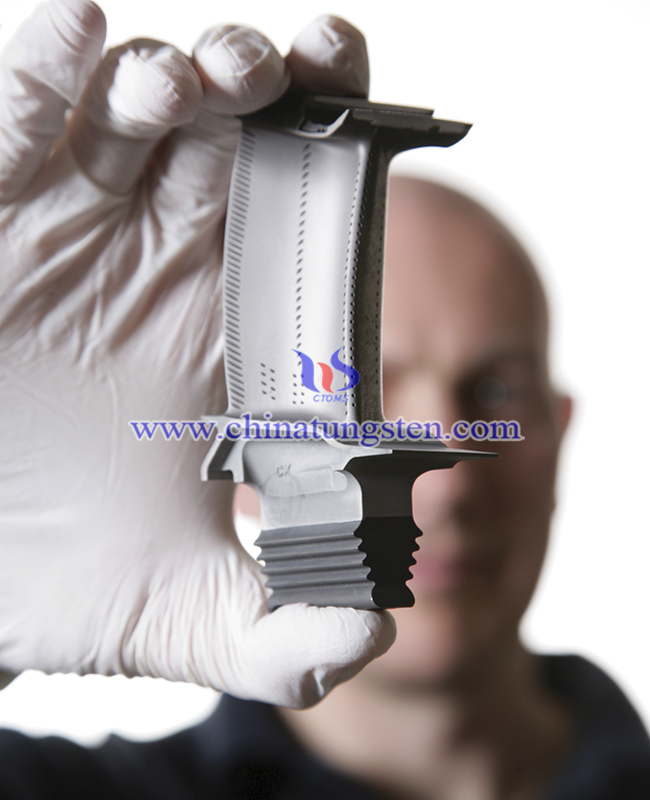Single Crystal Turbine Blade
- Details
- Category: Tungsten Information
- Published on Thursday, 19 July 2018 11:50
The single crystal blade is a cast blade with only one oriented crystal grain, which eliminates the lateral grain boundary sensitive to voids and cracks, so that all grain boundaries are parallel to the stress axis direction, thereby improving the performance of the alloy. In the past 60 years, single crystal turbine blades have been critical to the development of jet engines and have been an important technology for the development of the aircraft industry.
The main material of the blades used in aircraft engines is nickel-based superalloys. Normally, nickel can withstand high temperatures of around 1000 ° C, but it is easily oxidized and deformed at high temperatures, so it is necessary to add other refractory metal elements to keep the nickel-base superalloy blades strong and resistant to oxidation at extreme temperatures. This means that the nickel alloy blade material closest to the engine's combustion chamber must be guaranteed to operate at temperatures well above its melting point, and must be cooled to 80% to 90% of its melting temperature. The jet engine needs to meet 1,982 ° C. Therefore, alloy materials for engine blades are a key factor in determining the performance and longevity of an aircraft engine.

Usually the manufacture of ultra-high temperature resistant alloys that require vacuum casting to soften and melt between 1240 ° and 1371 ° C. The single crystal material is a powerful directional magnetic field generated by the electromagnet while the blade is being cast. The unsolidified superalloy is solidified in the same direction under the action of the directional magnetic field, and finally all the single crystals are arranged in the same direction, instead of being like The general steel and other molecules are in a mess, so that the neatly arranged materials can withstand higher temperatures.
The development of single crystal blades originated in the 1950s, and engineers in the United States spent about 10 years from concept to manufacturing. In 1966, American engineers created directional solidified columnar grain turbine blades, the first step toward single crystal blades containing carbon, boron and zirconium.
In general, the thermal efficiency of a jet engine increases with the temperature of the gas leaving the combustion chamber and entering the turbine. In the gas path of a high-performance jet engine, the turbine inlet temperature can exceed 1,600 ° C, carbon, boron and zirconium. Although the element preferentially segregates the grain boundary and provides high-temperature grain boundary strength and creep resistance, in the casting, the solidification time is long and there is no grain boundary, and the primary carbide is generated, thereby damaging the high and low fatigue characteristics of the blade.
In the 1970s, American engineers continued to improve on the basis of the first generation to create new alloys. This single crystal casting called "SX alloy" is still in service today. SX alloy eliminates carbon, boron and zirconium and replaces the new single crystal formulation, which includes nickel (59%), cobalt (10%), niobium (9%), aluminum (6%), tungsten (6%). And other elements (10%). Among the other elements, the most important material is bismuth (3%), which allows the final alloy to withstand higher temperatures before it weakens and melts. strontium is a by-product derived from specific copper-molybdenum ore, which is scarce and very expensive.
There is a misunderstanding. It is believed that it was only two years that researchers in China’s aircraft engine found that it was not. The element of strontium has long been known to scientists in China, but it has only made breakthroughs in the technology of manufacturing bismuth-containing single crystal alloys in recent years. It is precisely because of the breakthrough of this technology that China’s own “Woshan” series (WS series) aircraft engines have achieved very Great progress and rapid development of research and development.
The single crystal blade is a super alloy grown from a single crystal in a vacuum casting furnace. It increases the efficiency of the turbine and the life of individual blades while giving it unmatched resistance to high temperature creep and fatigue. In jet engines, the relative life of single crystal turbine airfoils in terms of creep strength and thermal fatigue resistance has been proven to be up to 9 times compared to equiaxed crystal blades, while corrosion resistance is more than 3 times higher than relative life. . Without these single-crystal airfoils, the modern turbine engine's turbine inlet temperature is high and long life is impossible (the US engine's overhaul time is about 25,000 hours). By eliminating grain boundaries, they extend the heat and fatigue life of jet engines and have a higher melting point and higher corrosion resistance. In addition, the blades can also use less material because they can also be hollow, reducing the weight of the jet engine. All of these improvements help to increase the efficiency of the gas turbine.
Turbine wings using SX alloy blades in the United States are installed in the P&W’s F100 production engine to power the F-15 and F-16 jet fighters. The first commercial aviation was used in P&W's JT9D-7R4 jet engine, which was certified in flight in 1982 and powered the Boeing 767 and Airbus A310. In 1986, the inventor of single crystal turbine blades, Pratt & Whitney won the ASM International Engineering Materials Achievement Award in recognition of his contribution to the aviation industry.
Now, single crystal turbine blade manufacturing technology has become the absolute high-end material core secret of aviation industry in various countries. SX alloy-based single crystal blades can still be found in many modern high-performance jet engines, including engines that power the F-22.
- Tungsten Manufacturer & Supplier, Chinatungsten Online: www.chinatungsten.com
- Tungsten News & Prices of China Tungsten Industry Association: www.ctia.com.cn
- Molybdenum News & Price: news.molybdenum.com.cn
- Tel.: 86 592 5129696; Fax: 86 592 5129797; Email: sales@chinatungsten.com



 sales@chinatungsten.com
sales@chinatungsten.com